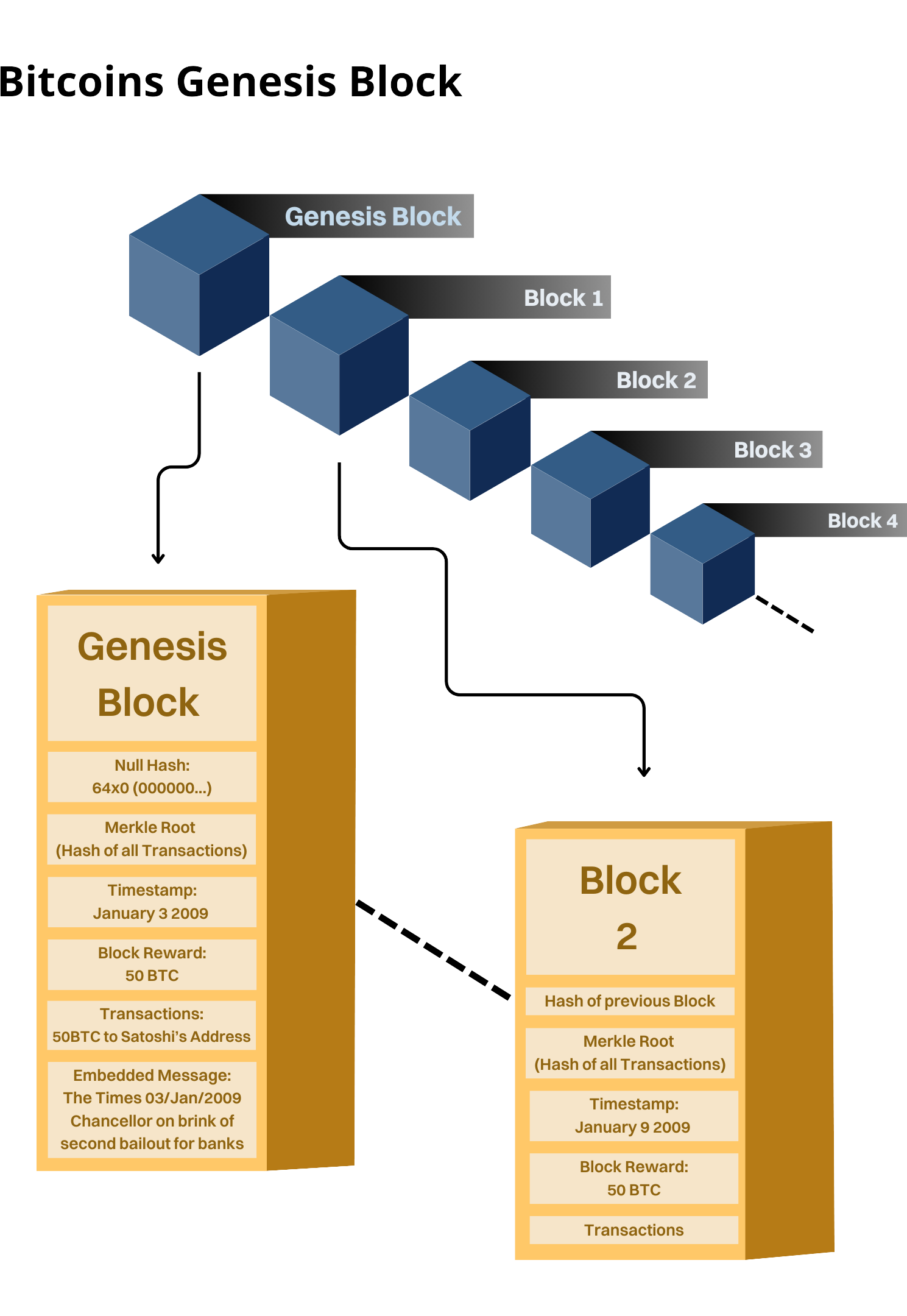Wallet Address of Satoshi Nakamoto - Bitcoins Genesis Block
Salomon Kisters
Aug 2, 2024This post may contain affiliate links. If you use these links to buy something we may earn a commission. Thanks!
Bitcoin, the world’s first decentralized digital currency, has become a global phenomenon, largely due to the mysterious figure known as Satoshi Nakamoto. As the creator of Bitcoin and the miner of the Genesis Block, Satoshi Nakamoto’s legacy is both legendary and shrouded in mystery. This article delves into the origins of Bitcoin, the enigmatic Satoshi Nakamoto, and the significance of the Genesis Block.
Who is Satoshi Nakamoto?
Satoshi Nakamoto is the pseudonymous creator of Bitcoin, a revolutionary cryptocurrency that has transformed the world of finance and technology. Despite numerous investigations and theories, the true identity of Satoshi Nakamoto remains unknown, sparking endless speculation.
Bitcoin’s Birth: In 2008, Nakamoto published the Bitcoin white paper, titled “Bitcoin: A Peer-to-Peer Electronic Cash System,” which outlined the concept of a decentralized digital currency. By January 3, 2009, Nakamoto mined the Genesis Block of Bitcoin, launching the first blockchain and forever altering the financial landscape.
Satoshi’s Impact: Satoshi’s creation has not only led to the birth of Bitcoin but has also inspired a multitude of other cryptocurrencies and blockchain projects. This pioneering work has initiated a global shift toward decentralization, challenging traditional financial systems.
Bitcoin’s Current Status: As of 2024, Bitcoin’s total market capitalization is over $550 billion, with a circulating supply of approximately 19.45 million BTC, illustrating its significant impact on the global economy. Bitcoin is now accepted as legal tender in some countries, including El Salvador, and is widely recognized as a hedge against inflation.
The Genesis Block and Its Importance
The Genesis Block, also known as Block 0, is the first block ever mined on the Bitcoin blockchain. It was created by Satoshi Nakamoto on January 3, 2009, marking the official launch of Bitcoin. The Genesis Block is unique due to its embedded message and hardcoded transactions.
The Embedded Message: The block contains a message that reads, “The Times 03/Jan/2009 Chancellor on brink of second bailout for banks.” This is widely interpreted as a critique of the existing centralized financial systems and the 2008 financial crisis caused by banking failures.
Creation of Bitcoins: Unlike typical blocks, the Genesis Block’s 50 Bitcoins were created from thin air and credited to the Bitcoin address 1A1zP1eP5QGefi2DMPTfTL5SLmv7DivfNa. This is whats known as Satoshi Nakamoto’s Bitcoin Address. These Bitcoins are not spendable, marking them as a unique element in Bitcoin’s history.
Mining and Block Rewards: In general, mining involves solving complex mathematical puzzles to add a block to the blockchain, rewarding the miner with newly minted Bitcoins. Initially, the reward was 50 BTC per block, but it has since halved every four years, in line with Bitcoin’s programmed halving events. The current block reward, as of 2024, is 3.125 BTC. This halving mechanism ensures the total supply of Bitcoin never exceeds 21 million.
Bitcoin’s Security and Decentralization: Bitcoin’s decentralized nature and cryptographic security make it an attractive platform for a variety of applications beyond just cryptocurrency. The blockchain has been used for secure identity verification, supply chain management, and voting systems, demonstrating its potential to revolutionize multiple industries.

Speculations About Satoshi’s Identity
The mystery surrounding Satoshi Nakamoto’s identity has led to numerous theories and claims. Several individuals have been rumored or claimed to be Satoshi, but none have provided conclusive proof.
Dorian Nakamoto: In 2014, a news outlet mistakenly identified Dorian Nakamoto, a Japanese-American man, as Bitcoin’s creator. This claim was later debunked, and Dorian Nakamoto publicly denied any involvement with Bitcoin.
Craig Wright: An Australian computer scientist who claimed to be Satoshi in 2016 but failed to provide sufficient evidence to support his claim. Despite ongoing legal battles, Wright’s assertion remains highly controversial and widely disputed.
Nick Szabo: A well-known computer scientist and cryptography expert, Szabo’s early work on digital currencies and blockchain technology, particularly his concept of “bit gold,” has led many to consider him a likely candidate for Satoshi.
Hal Finney: A notable early Bitcoin adopter and the first person to receive Bitcoins from Satoshi, Finney’s involvement in the Bitcoin community has fueled speculation about his connection to Satoshi. Finney was a highly respected cryptographer and a key figure in Bitcoin’s development.
- Current Developments: Despite these theories, Satoshi Nakamoto’s identity remains unknown. The Bitcoin community often values this anonymity, emphasizing the decentralized ethos that Satoshi instilled in the project. This mystery continues to captivate both enthusiasts and skeptics alike.
Comparing Genesis Blocks: Ethereum and Cardano
The concept of a Genesis Block is not unique to Bitcoin. Other cryptocurrencies like Ethereum and Cardano also have their own Genesis Blocks, marking the beginning of their blockchains.
Ethereum Genesis Block
- Creation Date: July 30, 2015
- Initial Supply: The Ethereum Genesis Block created the initial supply of Ether (ETH), which was distributed among early supporters through a crowdsale, commonly referred to as an Initial Coin Offering (ICO).
- Significance: Ethereum introduced smart contracts, enabling developers to build decentralized applications (dApps) on its blockchain, setting it apart from Bitcoin’s more straightforward transactional design. Ethereum’s move to a proof-of-stake consensus mechanism in 2022, known as “The Merge,” further distinguished its approach to scalability and energy efficiency.
Cardano Genesis Block
Creation Date: September 29, 2017
Initial Supply: Like Ethereum, Cardano’s Genesis Block distributed its native cryptocurrency, Ada (ADA), through a crowdsale.
Significance: Cardano focuses on scalability and security, aiming to provide a more robust platform for decentralized applications compared to its predecessors. Cardano’s development is characterized by a rigorous academic approach, incorporating peer-reviewed research into its protocol design.
Comparative Analysis: Both Ethereum and Cardano were developed to address limitations within the Bitcoin blockchain, offering innovative features and improvements. Ethereum’s adaptability with smart contracts and Cardano’s emphasis on formal verification and sustainability highlight the diverse approaches in the blockchain ecosystem.
Final Thoughts
The Genesis Block of Bitcoin stands as a symbol of Satoshi Nakamoto’s groundbreaking achievement in creating a decentralized digital currency. Unlike later cryptocurrencies, Bitcoin’s Genesis Block was unique, with its unspendable coins and embedded political message.
Satoshi’s Legacy: While some critics argue that Satoshi’s approach was unorthodox, the success and resilience of Bitcoin in the financial market underscore the ingenuity of its design. Satoshi’s legacy is not just the creation of Bitcoin but the inspiration for an entire industry focused on decentralization and the future of finance.
Bitcoin’s Evolution: As Bitcoin continues to evolve, innovations such as the Lightning Network are being developed to address scalability issues, making Bitcoin more accessible for everyday transactions. The rise of institutional adoption and regulatory discussions further illustrates Bitcoin’s integration into the global economy.
The Future of Cryptocurrency: The anonymity of Satoshi Nakamoto adds to the allure of Bitcoin, symbolizing the power and intrigue of anonymity in the digital age. As blockchain technology advances, the impact of Bitcoin and Satoshi Nakamoto’s vision will likely continue to inspire new innovations and shape the future of decentralized finance.
In conclusion, the legacy of Satoshi Nakamoto will likely persist, influencing future innovations and developments in blockchain technology, as Bitcoin solidifies its place in the evolving landscape of global finance.
Stay informed with the latest insights in Crypto, Blockchain, and Cyber-Security! Subscribe to our newsletter now to receive exclusive updates, expert analyses, and current developments directly to your inbox. Don't miss the opportunity to expand your knowledge and stay up-to-date.
Love what you're reading? Subscribe for top stories in Crypto, Blockchain, and Cyber-Security. Stay informed with exclusive updates.
Please note that the Content may have been generated with the Help of AI. The editorial content of OriginStamp AG does not constitute a recommendation for investment or purchase advice. In principle, an investment can also lead to a total loss. Therefore, please seek advice before making an investment decision.

Unraveling the Mystery of Satoshi Nakamoto: Bitcoin's Creator Revealed
Uncover the enigmatic figure behind Bitcoin's creation with the latest insights on Satoshi Nakamoto, the mysterious inventor of the world's first cryptocurrency.

The Mystery of the Message in the Bitcoin Genesis Block
When Satoshi Nakamoto created Bitcoin, he left a secret message. What is it, and what does it mean?

Why Can There Only Be 21 Million Bitcoins? Impact of Bitcoin's Fixed Supply
Discover why there can only be 21 million Bitcoins and the impact of Bitcoin's fixed supply on inflation control and scarcity.
Protect your documents
Your gateway to unforgeable data. Imprint the authenticity of your information with our blockchain timestamp